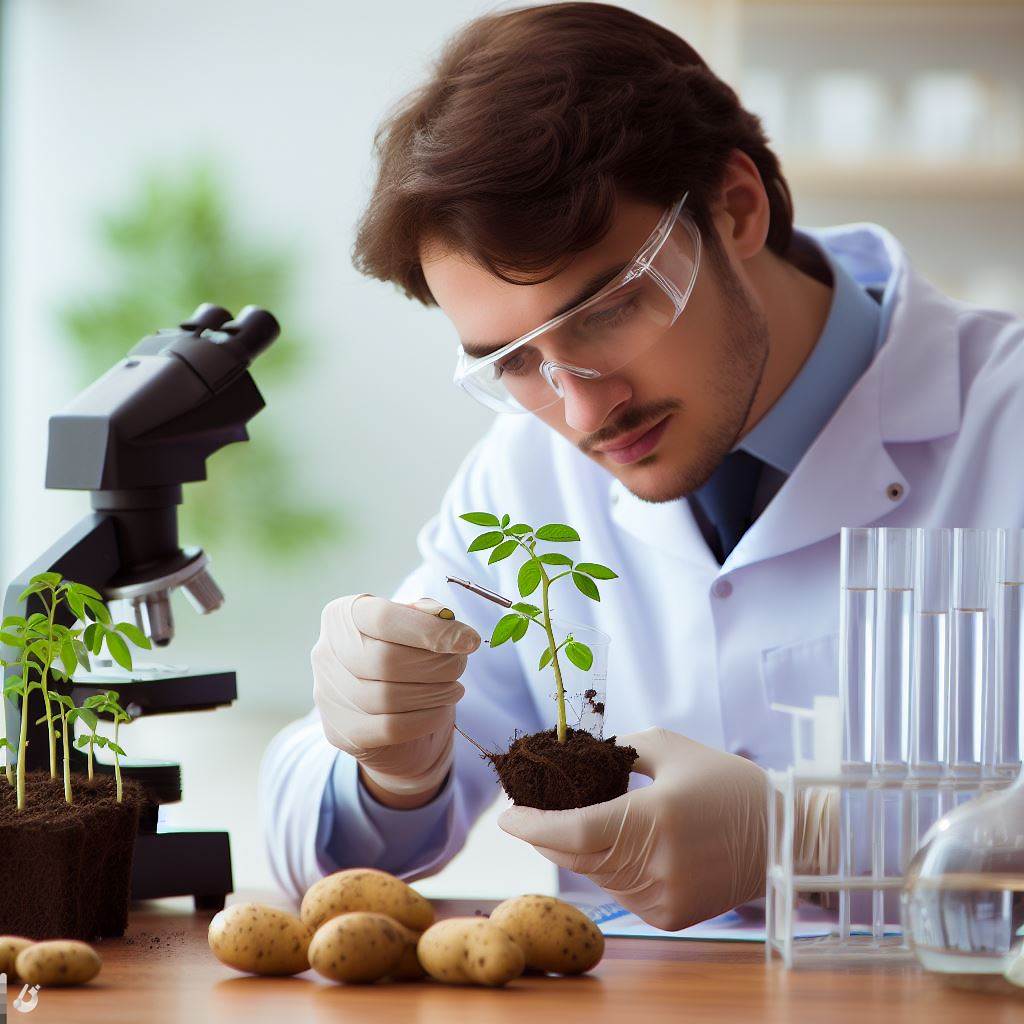Introduction
Potatoes are a staple crop that plays a vital role in global food security.
Understanding how climate change affects potato growth is crucial for farmers and food production.
In the agricultural theater where every seedling’s destiny is choreographed by the elements, the relationship between climate and crop growth is a captivating saga.
In this section, we delve into the intricate narrative of how climate, the maestro of environmental symphonies, orchestrates the growth of one of the world’s staple crops – the potato.
From the cool highlands to the sun-kissed plains, understanding the nuances of climate impact on potato cultivation is paramount for farmers, researchers, and enthusiasts alike.
As Earth’s climate undergoes unprecedented shifts, it profoundly influences temperature patterns, precipitation rhythms, and ecological balances.
The potato, with its versatile adaptability, becomes both a protagonist and a canvas upon which climate inscribes its story.
Join us in this exploration as we unearth the critical insights, unveil the challenges, and celebrate the opportunities presented by the dynamic dance between climate and potato growth.
From the microscopic intricacies of soil moisture to the macroscopic canvas of global climate trends, this section endeavors to equip you with a holistic understanding of the multifaceted interplay shaping the destiny of potatoes in a changing world.
Welcome to a journey where climate and crop converge, and where knowledge becomes the compass for sustainable potato cultivation.
Factors Affecting Potato Growth
Temperature
The temperature is a significant factor that can affect the growth of potatoes.
Understanding the ideal temperature range for potato growth is essential for successful cultivation.
Potatoes generally thrive in temperatures between 60°F and 70°F (15°C and 21°C).
This temperature range provides optimal conditions for the development of the plant and the formation of tubers.
It allows for the right balance between photosynthesis and tuber growth.
Transform Your Agribusiness
Unlock your farm's potential with expert advice tailored to your needs. Get actionable steps that drive real results.
Get StartedExtreme temperatures, whether too high or too low, can negatively impact potato growth.
When temperatures rise above 85°F (29°C), potatoes may experience heat stress. This can result in reduced tuber set and increased water requirements.
High temperatures can also lead to dormancy breaks, affecting the overall yield.
On the other hand, when temperatures drop below 50°F (10°C), potatoes can suffer from chilling injury.
This can cause tissue damage, resulting in lower yields and diseases.
Frost can be particularly destructive for potato plants, freezing the leaves and damaging the tubers.
Rainfall and Irrigation
The availability of water is crucial for potato growth.
Proper irrigation or adequate rainfall is necessary to provide sufficient moisture for the plants.
Potatoes require about 1 to 2 inches (2.5 to 5 cm) of water per week.
This ensures that the soil remains evenly moist, promoting healthy tuber development.
Without enough water, potatoes may experience water stress, resulting in stunted growth and reduced yields.
However, excessive water or poor drainage can also negatively impact potato growth.
Wet soil can lead to root rot and other diseases, inhibiting the plant’s ability to take up nutrients.
Additionally, waterlogged conditions can cause tubers to become waterlogged as well, affecting their quality.
Sunlight
Sunlight plays a vital role in the growth of potatoes.
It is necessary for photosynthesis, the process by which plants convert light energy into chemical energy to fuel their growth.
During photosynthesis, potato plants use sunlight to produce sugars, which are then transported to the developing tubers.
Sufficient sunlight exposure ensures that enough energy is generated for tuber development, resulting in larger and healthier potatoes.
Insufficient sunlight can have adverse effects on potato growth.
When plants do not receive enough light, their photosynthetic capacity is reduced, leading to weaker tuber development.
This can result in smaller, misshapen, or low-quality potatoes.
In essence, temperature, rainfall, and sunlight are essential factors that influence potato growth.
Understanding the ideal temperature range, ensuring adequate water supply, and providing sufficient sunlight are necessary for successful potato cultivation.
By optimizing these environmental conditions, farmers can maximize their potato yields and produce high-quality crops.
Showcase Your Farming Business
Publish your professional farming services profile on our blog for a one-time fee of $200 and reach a dedicated audience of farmers and agribusiness owners.
Publish Your ProfileRead: Organic Fertilizers: Boosting Soil Health
Climate Zones and Potato Cultivation
Different climate zones
Climate zones are geographical areas with similar weather patterns and environmental conditions.
They are categorized based on temperature, rainfall, humidity, and other climatic factors.
Different climate zones exist globally, such as tropical, subtropical, temperate, and polar.
Suitable climate zones for potato cultivation
The success of potato cultivation depends on selecting the right climate zone.
1. Best conditions for optimum potato growth
- A temperate climate with cool summers and mild winters is ideal for potato cultivation.
- Temperature between 15-20°C (59-68°F) is optimal for tuber development.
- Good rainfall, around 500-1,000 mm (20-40 in), evenly distributed throughout the growing season, is essential.
- Well-drained loam or sandy soil with a pH between 5.5-6.5 provides optimal conditions.
- Avoiding extreme temperature fluctuations and frost is crucial for successful harvest.
2. Challenges in cultivating potatoes in different climate zones
- Tropical and subtropical zones pose challenges due to high temperatures and excessive rainfall.
- High temperatures above 30°C (86°F) can hinder tuber set and development.
- Excessive rainfall or waterlogged soil can lead to diseases like late blight and potato rots.
- Potatoes grown in polar zones face short growing seasons with cold temperatures and limited sunlight.
- Extreme cold can damage the plants, and lack of sunlight affects tuber formation.
Overall, choosing the right climate zone plays a significant role in potato cultivation success.
While temperate zones provide the most favorable conditions for optimum growth, tropical, subtropical, and polar regions present challenges.
With careful planning, crop management, and the use of suitable varieties and farming techniques, potatoes can be cultivated in diverse climate zones.
Read: Irrigation Methods for Rice: Maximizing Yield

Uncover the Details: Smart Irrigation Techniques for Dry Climates
Impact of Climate Change on Potato Growth
Overview of the changing climate patterns
Climate change refers to long-term alterations in various climate factors, such as temperature, precipitation, and extreme weather events.
These changes are primarily caused by human activities, including the burning of fossil fuels and deforestation.
As a result, global temperatures have been steadily rising, leading to significant impacts on various ecosystems, including agriculture.
Effects of climate change on potato cultivation
1. Rise in air temperature and its consequences
Increasing temperatures have a direct impact on potato growth, development, and overall productivity.
As the average global temperature rises, potato plants become more vulnerable to heat stress.
High temperatures affect a plant’s physiological processes, such as photosynthesis and respiration, which ultimately reduce crop yields.
2. Changing precipitation patterns and their impact
Climate change also influences precipitation patterns, leading to increased frequency and severity of droughts and floods.
These changing patterns pose significant challenges to potato cultivation.
Droughts limit water availability, leading to moisture stress, reduced tuber formation, and stunted plant growth.
Conversely, heavy rainfall and flooding can result in waterlogged soils, causing root and tuber rot.
Strategies to mitigate the negative impacts of climate change on potato growth
1. Crop management techniques
Implementing appropriate crop management techniques becomes crucial to adapting to the changing climate conditions.
Practices like conservation tillage, crop rotation, and proper irrigation management can help conserve moisture in the soil, reduce evaporation, and enhance water use efficiency.
Additionally, the use of organic matter and cover crops can improve soil fertility and moisture retention.
2. Usage of drought-tolerant and heat-resistant potato varieties
Utilizing drought-tolerant and heat-resistant potato varieties developed through breeding programs is another effective strategy.
These improved cultivars have traits that enable them to withstand higher temperatures and thrive in drought conditions.
By planting such varieties, farmers can minimize the negative impact of climate change on potato production.
In summary, climate change poses significant challenges to potato cultivation.
Rising temperatures and changing precipitation patterns affect the growth and development of potato plants, ultimately leading to reduced yields.
However, by adopting appropriate crop management techniques and incorporating drought-tolerant and heat-resistant potato varieties, farmers can mitigate the negative impacts of climate change on potato growth.
These strategies are vital to ensure future food security and sustainability in the face of changing climatic conditions.
Read: Pest Control in Corn Fields: Effective Strategies
Case Studies: Climate Impact on Potato Growth in Different Regions
Temperature fluctuations in a potato-growing region
Temperature fluctuations in a potato-growing region have significant effects on the crop’s growth and yield.
Fluctuating temperatures can lead to reduced yields, poor tuber quality, and increased disease susceptibility.
Local farmers in the region have implemented various measures to adapt to the changing climate.
Farmers monitor temperature changes closely and adjust planting schedules accordingly.
They also employ irrigation techniques to regulate soil temperature and protect the crops.
Furthermore, farmers use mulching and cover crops to maintain optimal soil temperature and moisture levels.
Some farmers have invested in greenhouse technologies to create controlled environments for potato cultivation.
By adopting these adaptive measures, farmers mitigate the negative impact of temperature fluctuations and ensure potato crop success.
Irregular rainfall patterns affecting potato production
Irregular rainfall patterns pose significant challenges to potato production in certain regions.
Showcase Your Farming Business
Publish your professional farming services profile on our blog for a one-time fee of $200 and reach a dedicated audience of farmers and agribusiness owners.
Publish Your ProfileInsufficient or excessive rainfall can lead to water stress, reduced tuber size, and lower yields.
Local farmers have recognized the importance of adopting irrigation techniques to combat water scarcity.
Drip irrigation systems have been widely adopted to deliver precise amounts of water directly to the crops’ root zones.
This method ensures optimal moisture levels and reduces water wastage.
Some farmers have also constructed rainwater harvesting systems, allowing them to utilize rainwater during dry periods.
Additionally, farmers practice water conservation methods such as mulching to minimize evaporation.
The use of drought-resistant potato varieties has also gained popularity in regions with irregular rainfall patterns.
In a nutshell, these case studies highlight the significant impact of climate on potato growth and the measures taken by local farmers to adapt to these challenges.
Temperature fluctuations and irregular rainfall patterns require farmers to closely monitor weather conditions and implement adaptive strategies.
By adopting irrigation techniques, utilizing mulching, and investing in greenhouse technologies, farmers are able to mitigate the negative impact of climate change and ensure successful potato production.
Additionally, the utilization of drought-resistant varieties and rainwater harvesting systems further contribute to sustaining potato growth in different regions.
Overall, these case studies provide valuable insights for potato farmers facing climate-related challenges.
Read: Tomato Cultivation: Tips for a Healthy Crop
Find Out More: Pesticides: Impact on Soil Health
Uncover the Details: Tech Advances in Crop Planting
Conclusion
We’ve explored the pivotal role climate plays in potato growth, from temperature sensitivity to precipitation needs.
Understanding climate impact is crucial for farmers to optimize yields, reduce risks, and ensure sustainable agriculture.
Expand research on climate-resilient potato varieties, agronomic techniques, and adaptive strategies for sustainable cultivation.
Implement eco-friendly methods to mitigate climate impact, emphasizing water conservation, soil health, and responsible resource management.
Acknowledging and acting upon climate influences is pivotal for sustaining potato cultivation in the face of a dynamic environment.
Let’s cultivate resilience.




